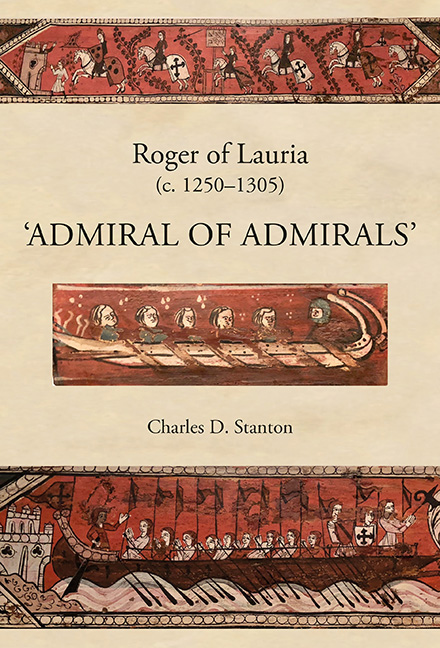Book contents
- Frontmatter
- Dedication
- Contents
- List of Illustrations
- Prologue
- 1 Battle of Benevento (26 February 1266)
- 2 A Calabrian Exile in the Court of Aragon (1262–1282)
- 3 Battle of Tagliacozzo (23 August 1268)
- 4 Aragonese Expansion (1229–1282)
- 5 Angevin Consolidation and Aggrandizement (1268–1282)
- 6 Revolt of the Vespers (30 March 1282)
- 7 Aragonese Intervention (August–October 1282)
- 8 Stalemate (November 1282–March 1283)
- 9 Admiral of Aragon (20 April 1283)
- 10 The Opposing Fleets (1282–1302)
- 11 Battle of Malta (8 June 1283)
- 12 Anjou's Dreams of Empire Dashed (June–November 1284)
- 13 France's Crusade Against Aragon (May–November 1285)
- 14 Battle of the Counts (23 June 1287)
- 15 Truces and Treaties (June 1287–November 1291)
- 16 Raid on Romania (Summer 1292)
- 17 Switching Sides (December 1293–April 1297)
- 18 Aragon's Invasion of Sicily at Anjou's Bidding (1298/1299)
- 19 Lauria's Last Great Campaign (Summer 1299–Spring 1300)
- 20 Endgame (Spring 1301–Summer 1302)
- Epilogue
- Bibliography
- Index
20 - Endgame (Spring 1301–Summer 1302)
Published online by Cambridge University Press: 24 October 2019
- Frontmatter
- Dedication
- Contents
- List of Illustrations
- Prologue
- 1 Battle of Benevento (26 February 1266)
- 2 A Calabrian Exile in the Court of Aragon (1262–1282)
- 3 Battle of Tagliacozzo (23 August 1268)
- 4 Aragonese Expansion (1229–1282)
- 5 Angevin Consolidation and Aggrandizement (1268–1282)
- 6 Revolt of the Vespers (30 March 1282)
- 7 Aragonese Intervention (August–October 1282)
- 8 Stalemate (November 1282–March 1283)
- 9 Admiral of Aragon (20 April 1283)
- 10 The Opposing Fleets (1282–1302)
- 11 Battle of Malta (8 June 1283)
- 12 Anjou's Dreams of Empire Dashed (June–November 1284)
- 13 France's Crusade Against Aragon (May–November 1285)
- 14 Battle of the Counts (23 June 1287)
- 15 Truces and Treaties (June 1287–November 1291)
- 16 Raid on Romania (Summer 1292)
- 17 Switching Sides (December 1293–April 1297)
- 18 Aragon's Invasion of Sicily at Anjou's Bidding (1298/1299)
- 19 Lauria's Last Great Campaign (Summer 1299–Spring 1300)
- 20 Endgame (Spring 1301–Summer 1302)
- Epilogue
- Bibliography
- Index
Summary
CHASTENED BUT UNDETERRED by the mixed results of his last expedition, Roger of Lauria settled upon an even more aggressive naval strategy the following year to bring Sicily to heel. Subduing the island clearly depended upon extending the Angevin power base beyond Catania and the Val di Noto; and the most efficient means of doing that was to impose naval supremacy on Sicily's shores through the vigorous use of the Angevin fleet – especially since the Sicilians no longer possessed a fleet to oppose it. Accordingly, Roger first returned to Naples in order to acquire more supplies to replenish Angevin strongholds on the eastern end of the island and to procure more ships for the fleet. When he sailed back to Catania in the spring of 1301 having achieved his purpose, the admiral shared his strategy with the duke: they would divide the armada into two squadrons with Roger leading one to subjugate the northern shores while Robert took the other to suppress the southern littoral (Map 6).
The plan's implementation, of course, turned out to be much more problematic than its conception. Unsurprisingly, a pronounced dichotomy in seamanship and judgment dictated that Robert would fare far worse than Roger. The former chose to begin his cruise by assailing Syracuse, despite the fact that, two years before, the city had so stubbornly resisted James II of Aragon that the king had been compelled to abandon his first effort to conquer the island altogether, having achieved little. Predictably, the Syracusans summarily dismissed their assailants on this occasion as well, prompting the Angevins to move on to Scicli (just south of Ragusa), which also rebuffed them. In July, Robert's fleet found itself sailing by Scoglitti (a few miles up the coast towards Gela), when a violent storm struck it from the southwest. Gale force winds drove many of the ships ashore despite frantic attempts to anchor them. Niccolo Speciale reported that twenty-two galleys broke up on the rocks at Camerina just southeast of Scoglitti near modern-day Marina di Ragusa. The duke and the rest of his fleet would have suffered a similar fate, had not the captain of his flagship decided to run before the wind instead of fighting it.
- Type
- Chapter
- Information
- Roger of Lauria (c.1250–1305)‘Admiral of Admirals’, pp. 289 - 301Publisher: Boydell & BrewerPrint publication year: 2019

